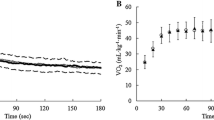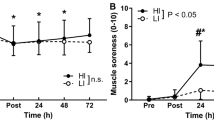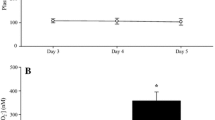Abstract
The present study investigated the relationship between plasma potassium ion concentration ([K+]) and skeletal muscle torque during three different 15-min recovery periods after fatigue induced by four 30-s sprints. Four males and one female completed the multiple sprint exercise on three separate days; recovery was passive, i.e. no cycling exercise (PRec), active cycling at 30% peak oxygen consumption \(\dot V\)O2peak (30% Rec) and active cycling at 60% \(\dot V\)O2peak (60% Rec). Plasma [K+] was measured from blood sampled from an antecubital vein of subjects at rest and at 0, 3, 5, 10 and 15 min into each recovery. Isokinetic leg strength was measured at rest and at 1, 6, 11 and 16 min during each recovery. Following the exhaustive sprints, [K+] increased significantly from an average mean (SEM) resting value of 3.81 (0.07) mmol · l−1 to 4.48 (0.19) mmol · l−1 (P < 0.01). In all recovery conditions, plasma [K+] returned to resting levels within 3 min following the fourth sprint. However, in the two active recovery conditions plasma [K+] increased over the remainder of the recovery periods to 4.36 (0.12) mmol · l−1 in the 30% Rec condition and 4.62 (0.12) mmol · l−1 in the 60% Rec condition, the latter being significantly higher than the former (P < 0.01). The maximum torque measured following the sprints decreased significantly, on average, to 61.1 (8.36)% of peak levels (P < 0.01). After 15 min of recovery, maximum torque was highest in the 30% Rec condition at 92.13 (3.06)% of peak levels (P < 0.01), compared to 85.23 (3.64)% and 85.71 (0.82)% for the PRec and 60% Rec conditions, respectively. In contrast to the significant differences in plasma [K+] across all three recovery conditions, muscle torque recovery was significantly different in only the 30% Rec condition. In summary, recovery of peak levels of muscle torque following fatiguing exercise does not appear to follow changes in plasma [K+].
Similar content being viewed by others
Author information
Authors and Affiliations
Additional information
Accepted: 18 October 1996
Rights and permissions
About this article
Cite this article
McEniery, C., Jenkins, D. & Barnett, C. The relationship between plasma potassium concentration and muscle torque during recovery following intense exercise. Eur J Appl Physiol 75, 462–466 (1997). https://doi.org/10.1007/s004210050189
Issue Date:
DOI: https://doi.org/10.1007/s004210050189




